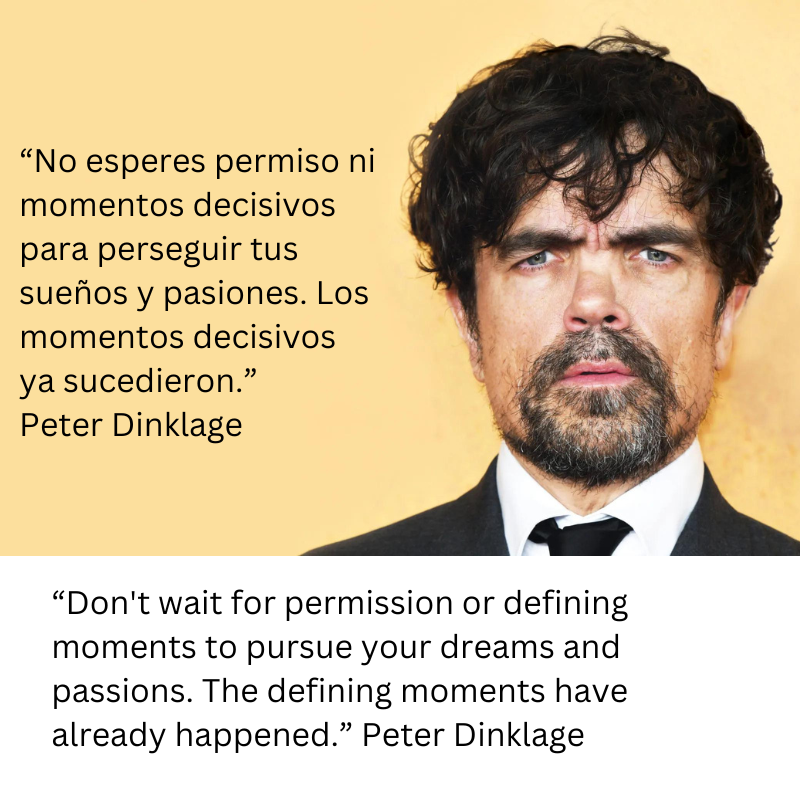English
Youtube address: https://www.youtube.com/watch?v=k9PpVEPlGVo (not the original)
Peter Dinklage speech to the graduating class of 2012 at Bennington College in Vermont, where he was an alumnus. “Emmy and Golden Globe Award winner Peter Dinklage ’91 returned to campus on June 1, 2012 to deliver the year’s Commencement.
Key messages from the speech:
- Don’t wait for permission or defining moments to pursue your dreams and passions. The defining moments have already happened.
- Be willing to fail and keep trying. Failure is part of the process. The quote “Ever tried. Ever failed. No matter. Try Again. Fail again. Fail better.” (Samuel Beckett) is referenced.
- Don’t wait until you feel fully ready. Get started and show the world what you can do through your actions.
- Find your own rhythm and path in life. It may take time, but trust that it will come.
- Treat others kindly and make a positive impact on the world around you.

Español
Discurso de Peter Dinklage ante la promoción de 2012 en Bennington College en Vermont, donde fue alumno. “El ganador del premio Emmy y Globo de Oro, Peter Dinklage ’91, regresó al campus el 1 de junio de 2012 para pronunciar la ceremonia de graduación del año.
Mensajes clave del discurso:
- No esperes permisos ni momentos decisivos para perseguir tus sueños y pasiones. Los momentos decisivos ya sucedieron.
- Estar dispuesto a fracasar y seguir intentándolo. El fracaso es parte del proceso. La cita “Alguna vez lo intenté. Alguna vez fallé. No importa. Vuelva a intentarlo. Falle de nuevo. Falle mejor”. (Samuel Beckett) está referenciado.
- No espere hasta sentirse completamente preparado. Comienza y muestra al mundo lo que puedes hacer a través de tus acciones.
- Encuentra tu propio ritmo y camino en la vida. Puede que lleve tiempo, pero confía en que llegará.
- Trata a los demás con amabilidad y genera un impacto positivo en el mundo que te rodea.
Discurso completo en: https://whatrocks.github.io/commencement-db/2012-peter-dinklage-bennington-college/
P.D. Samuel Beckett wrote the following:
“Worstward Ho” is an experimental prose piece written by Samuel Beckett in 1983, near the end of his life. It is a highly condensed and fragmented work that pushes language to its limits in exploring themes of failure, negation, and the struggle to express the inexpressible.
The piece consists of a series of short, enigmatic paragraphs that seem to describe a minimal scene or setting with vague shapes, figures or “shades” in a dim void or space. The language is pared down, repetitive, and at times contradictory, circling around itself in a way that resists straightforward meaning or narrative.
Some key elements that emerge:
- A sense of radical reduction to essentials – “bodies” without minds, just bones, a skull, a staring eye
- A striving towards “nohow” or nothingness, a negation of being
- The injunction to “fail better” at this process of negation/reduction
- The dim void/space as a kind of primordial scene of existence at its barest
- Vague anthropomorphized figures like an “old man” and “child” plodding on
- An agonizing sense of the limitations and failure of language itself to capture whatever is being grasped at
So while highly opaque and resistant to interpretation, the work seems to explore through its fragmented, pared-down style the boundaries of perception, being, language, and the possibility of representation after all has been stripped away. It is a late work that brings Beckett’s lifelong inquiry into the limits of language and existence to an extreme minimalist pitch. [1]
Referencias:
https://genius.com/Samuel-beckett-worstward-ho-annotated
“Worstward Ho” es una pieza en prosa experimental escrita por Samuel Beckett en 1983, cerca del final de su vida. Es una obra muy condensada y fragmentada que lleva el lenguaje al límite al explorar temas de fracaso, negación y la lucha por expresar lo inexpresable.
La pieza consta de una serie de párrafos breves y enigmáticos que parecen describir una escena o escenario mínimo con formas, figuras o “sombras” vagas en un vacío o espacio tenue. El lenguaje es simplificado, repetitivo y a veces contradictorio, dando vueltas alrededor de sí mismo de una manera que se resiste al significado o la narrativa directa.
Algunos elementos clave que emergen:
- Una sensación de reducción radical a lo esencial: “cuerpos” sin mente, sólo huesos, una calavera, un ojo fijo.
- Un esfuerzo hacia el “nohow” o la nada, una negación del ser.
- El mandato de “fallar mejor” en este proceso de negación/reducción.
- El oscuro vacío/espacio como una especie de escena primordial de la existencia en su forma más básica.
- Figuras vagas antropomorfizadas como un “anciano” y un “niño” caminando pesadamente
- Una sensación agonizante de las limitaciones y el fracaso del lenguaje mismo para capturar lo que se está captando.
Entonces, si bien es muy opaca y resistente a la interpretación, la obra parece explorar a través de su estilo fragmentado y minimalista los límites de la percepción, el ser, el lenguaje y la posibilidad de representación después de que todo ha sido eliminado. Es una obra tardía que lleva la investigación de toda la vida de Beckett sobre los límites del lenguaje y la existencia a un tono extremadamente minimalista.
Resume> Dr. Luis Elizondo
